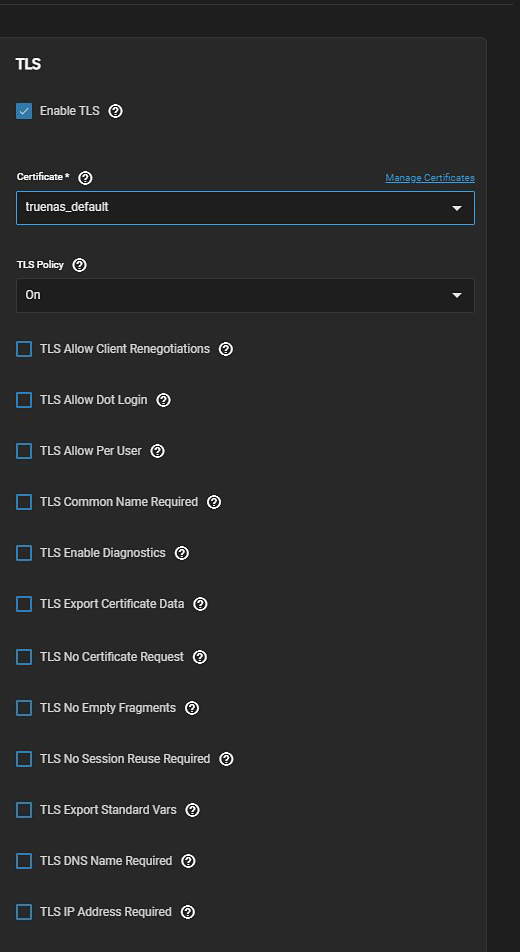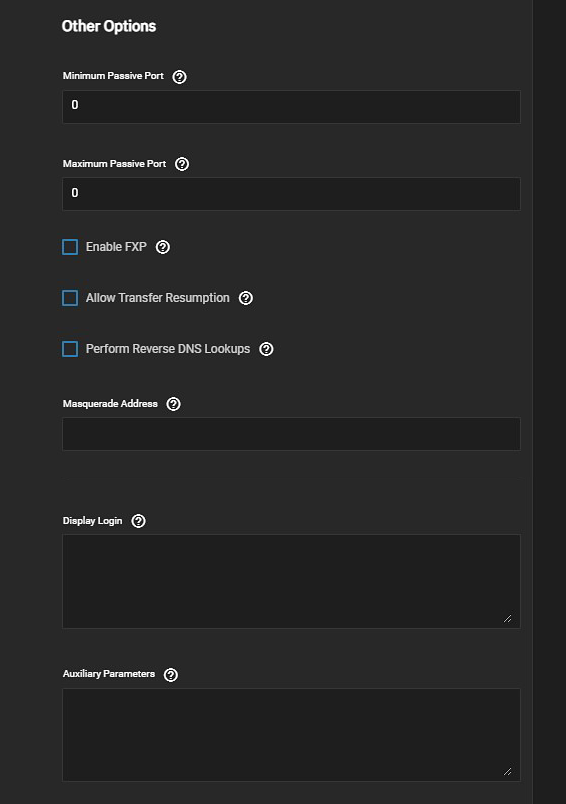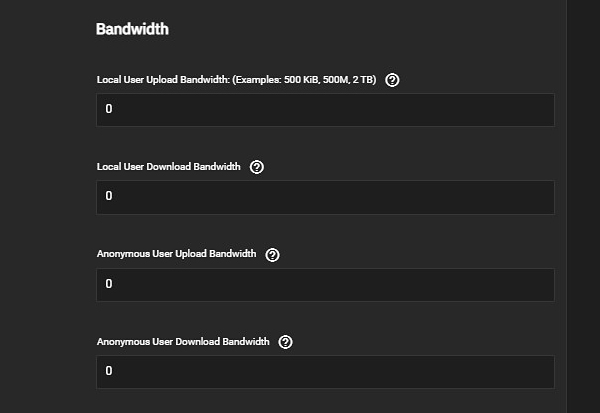FTP Service Screen
6 minute read.
The File Transfer Protocol (FTP) is a simple option for data transfers. The SSH options provide secure transfer methods for critical objects like configuration files, while the Trivial FTP options provide simple file transfer methods for non-critical files.
The FTP service has basic and advanced setting options. Click the edit for FTP to open the Basic Settings configuration screen.
To configure FTP, go to System > Services and find FTP, then click edit.
| Settings | Description |
|---|---|
| Port | Enter the port the FTP service listens on. |
| Clients | Enter the maximum number of simultaneous clients. |
| Connections | Enter the maximum number of connections per IP address. 0 is unlimited. |
| Login Attempts | Enter the maximum attempts before the client disconnects. Increase if users are prone to misspellings or typos. |
| Notransfer Timeout | Enter the maximum number of seconds a client is allowed to spend connected, after authentication, without issuing a command which results in creating an active or passive data connection (sending/receiving a file or receiving a directory listing). |
| Timeout | Enter the maximum client idle time in seconds before disconnecting. The default value is 600 seconds. |
Advanced Settings include the General Options on the Basic Settings configuration screen and allow you to specify access permissions, TLS settings, bandwidth, and other settings to customize FTP access.
Access settings specify user login, file, and directory access permissions.
| Settings | Description |
|---|---|
| Always Chroot | Only allows users to access their home directory if they are in the wheel group. This option increases security risk. To confine FTP sessions to a local user home directory, enable chroot and select Allow Local User Login. |
| Enable TLS when possible (especially when exposing FTP to a WAN). TLS effectively makes this FTPS for better security. | |
| Allow Anonymous Login | Select to allow anonymous FTP logins with access to the directory specified in Path. Selecting this displays the Path field. Enter or browse the location to populate the field. |
| Allow Local User Login | Select to allow any local user to log in. Only members of the ftp group may log in by default. |
| Require IDENT Authentication | Select to require IDENT authentication. Setting this option results in timeouts when IDENT is not running on the client. |
| File Permissions | Select the default permissions for newly created files. |
| Directory Permissions | Select the default permissions for newly created directories. |
TLS settings specify the authentication methods, such as if you want to encrypt the data you transfer across the Internet.
| Settings | Description |
|---|---|
| Enable TLS | Select to allow encrypted connections. Requires a certificate (created or imported using Credentials > Certificates). |
| Certificate | Select the SSL certificate for TLS FTP connections from the dropdown list. Click Manage Certificates to go to Credentials > Certificates. |
| TLS Policy | Select the policy from the dropdown list of options. Options are On, off, Data, !Data, Auth, Ctrl, Ctrl + Data, Ctrl +!Data, Auth + Data or Auth +!Data. Defines whether the control channel, data channel, both channels, or neither channel of an FTP session must occur over SSL/TLS. The policies are described here. |
| TLS Allow Client Renegotiations | Select to allow client renegotiation. We do not recommend this option. Setting this option breaks several security measures. See mod_tls for details. |
| TLS Allow Dot Login | TrueNAS checks the user home directory for a |
| TLS Allow Per User | Select to allow sending a user password unencrypted. |
| TLS Common Name Required | Select to require the common name in the certificate to match the FQDN of the host. |
| TLS Enable Diagnostics | Select for more verbose logging, which is helpful when troubleshooting a connection. |
| TLS Export Certificate Data | Select to export the certificate environment variables. |
| TLS No Certificate Request | Select if the client cannot connect, likely because the client server is not correctly handling the server certificate request. |
| TLS No Empty Fragments | Not recommended. This option bypasses a security mechanism. |
| TLS No Session Reuse Required | This option reduces connection security. Only use it if the client does not understand reused SSL sessions. |
| TLS Export Standard Vars | Select to set several environment variables. |
| TLS DNS Name Required | Select to require the client DNS name to resolve to its IP address and the cert contain the same DNS name. |
| TLS IP Address Required | Select to require the client certificate IP address to match the client IP address. |
Auxiliary parameters are an unsupported configuration. Parameters entered here are not validated and can cause undefined system behavior, including data corruption or data loss.
| Settings | Description |
|---|---|
| Minimum Passive Port | Enter a numeric value. Used by clients in PASV mode. A default of 0 means any port above 1023. |
| Maximum Passive Port | Enter a numeric value. Used by clients in PASV mode. A default of 0 means any port above 1023. |
| Enable FXP | Select to enable the File eXchange Protocol (FXP). We do not recommend FXP since it leaves the server vulnerable to FTP bounce attacks. |
| Allow Transfer Resumption | Select to allow FTP clients to resume interrupted transfers. |
| Perform Reverse DNS Lookups | Select to allow performing reverse DNS lookups on client IPs. This option causes long delays if you do not configure reverse DNS. |
| Masquerade Address | Enter a public IP address or host name. Use when FTP clients cannot connect through a NAT device. |
| Display Login | Enter a message that displays to local login users after authentication. Anonymous login users do not see this message. |
| Auxiliary Parameters | Used to add additional proftpd(8) parameters. |
Bandwidth settings specify the space you want to allocate for local and anonymous user uploads and downloads.
When configuring FTP bandwidth settings, we recommend manually entering the units you want to use, e.g. KiB, MiB, GiB.
| Settings | Description |
|---|---|
| Local User Upload Bandwidth: (Examples: 500 KiB, 500M, 2 TB) | Enter a value in KiBs or greater. A default of 0 Kib means unlimited. If you do not specify a measurement, it defaults to KiB. This field accepts human-readable input in KiBs or greater (M, GiB, TB, etc.). The default 0 KiB is unlimited. |
| Local User Download Bandwidth | Enter a value in KiBs or greater. A default of 0 Kib means unlimited. If you do not specify a measurement, it defaults to KiB. This field accepts human-readable input in KiBs or greater (M, GiB, TB, etc.). The default 0 KiB is unlimited. |
| Anonymous User Upload Bandwidth | Enter a value in KiBs or greater. A default of 0 Kib means unlimited. If you do not specify a measurement, it defaults to KiB. This field accepts human-readable input in KiBs or greater (M, GiB, TB, etc.). The default 0 KiB is unlimited. |
| Anonymous User Download Bandwidth | Enter a value in KiBs or greater. A default of 0 Kib means unlimited. If you do not specify a measurement, it defaults to KiB. This field accepts human-readable input in KiBs or greater (M, GiB, TB, etc.). The default 0 KiB is unlimited. |








